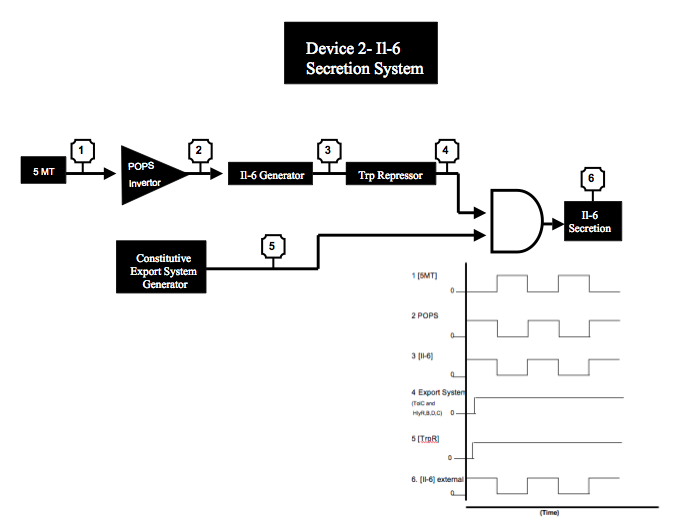IGEM:Stanford/2009/Project Homeostasis/Immunosuppression Device
<html> <style> /*----- General */ body {
background: black; color: black;
} </style> </html>
<html> <head> <style type="text/css";
color:white;
font-style:italic;
font-family:Arial;
font-size: 1px;
>
</style> </head>
</html>
<html> <head> <style type="text/css";
color:white;
font-style:italic;
font-family:Arial;
font-size: 3px;
>
</style> </head>
</html>
| Project |
| Research Proposal |
| Systems Overview |
| Cloning Plan |
| Sequences & Primers |
| Anti-Inflammation |
| Device Overview |
| Parts Design |
| Challenges |
| Results |
| Anti-Immunosuppression |
| Device Overview |
| Parts Design |
| Challenges |
| Results |
| Protocols |
| Modeling |
| Overview |
| Notebook |
| Results |
| Future Work |
| Archived Work |
Summary
The anti-immunosuppressive device consists of two components: a sensor and a responder. The sensor will detect local concentrations of a marker indicative of Treg-driven immunosuppression. When the levels of this input signal reach above a certain baseline threshold, the sensor will induce activity from the responder. The resulting output signal will modify the local cytokine milieu to support differentiation of pro-inflammatory Th17 cells and repress the immunosuppressive Treg lineage.
Parts Designs
Page Covering Our Parts Designs
Comments
- Rather than looking at metabolic changes due to Th17 cells, maybe we should look at precursor changes that result in Th17 differentiation. Think of it as a feed forward mechanism. I am thinking in particular things that are affected by Aryl Hydrocarbon Receptor (AHR) and RAR-related orphan receptor gamma (RORy).
- Check out this paper on Th17 And Treg control. http://www.nature.com/nature/journal/v453/n7191/abs/nature06880.html
Other Considerations
To what extent will 5-methyltryptophan inhibit growth of our machine? 5-methyltryptophan has been identified as an antimetabolite that induces false feedback inhibition of the trp biosynthetic pathway.
Other potential "input" signals: IL-10, TGF-beta, byproducts of HO-1 Other potential "output" signals: IL-17, IL-1-beta, CpG DNA, TLR stimuli
Challenges
Results
Sources
Treg markers/possible input signals
- Oliveira et al. Regulatory T cell maintenance of dominant tolerance: induction of tissue self-defense? Transpl Immunol. 2006 Dec;17(1):7-10. Epub 2006 Oct 12. Mentions the small molecule markers produced as a result of Treg-induction of IDO and HO-1.
Trp analogues
- Heatwole et al. Cloning, nucleotide sequence, and characterization of mtr, the structural gene for a tryptophan-specific permease of Escherichia coli K-12. J Bacteriol. 1991 January; 173(1): 108–115.
- Kuhn et al. Mutant Strains of Escherichia coli K-12 Exhibiting Enhanced Sensitivity to 5-Methyltryptophan. J Bacteriol. 1972 October; 112(1): 93–101.
